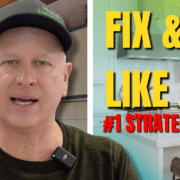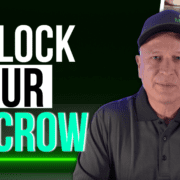How Escrow Can Make or Break Your Fix & Flip Investment
Why Escrow Matters
Today we are going to discuss how escrow can make or break your fix & flip investment. In a fix and flip, escrow can be your best friend—or the thing that slows your project to a crawl. When you understand how it works, you can keep your rehab moving fast, avoid costly delays, and protect your profits.
What Is Escrow in a Fix & Flip Loan?
Escrow is the money your lender sets aside for repairs.
It’s there to turn an undervalued property into a market-ready one.
Example:
If you buy a home for $150,000 and budget $40,000 for repairs, the lender might escrow that $40,000.
Lenders want to be sure that money goes to the agreed repairs, not something else. That’s why they hold it in escrow instead of handing it to you all at once.
What Escrow Usually Covers
Every lender is different, but escrow most often covers:
-
Repairs and rehab work from your approved budget
-
Certain agreed costs, like insurance or utilities (if negotiated before closing)
Tip: Always get a clear list from your lender before you close. If it’s not in writing, don’t count on it being covered.
What Escrow Usually Does NOT Cover
Escrow funds are not for:
-
Your monthly loan payments (except in rare cases)
-
Surprises or changes you decide to make mid-project
-
Closing costs
-
Ordering materials ahead of time (pre-orders) unless installed and inspected
Example:
If you decide halfway through to add a deck or upgrade all the windows—without it being in your original budget—you’ll likely need to pay for it yourself.
Why Lenders Use Escrow
Lenders lend based on the property being market-ready. Escrow ensures the repairs get done as planned.
They’ll release the funds only after they confirm the work is complete—sometimes with an inspection or permits.
How Escrow Works Step-by-Step
-
You do the work. Pay contractors or buy materials.
-
You submit proof. Bills, permits, or inspection sign-offs go to the lender.
-
They approve. The lender verifies the work is done.
-
You get reimbursed. The money goes to you or directly to your contractor.
Note: Some lenders release 10–20% of escrow at closing, but most wait until work is verified.
The Role of Speed in Your Profits
Speed is everything in flipping. The faster you finish, the fewer payments you make, and the sooner you can sell.
Example:
If you finish in 3 months instead of 6, that’s 3 months of payments saved and extra time to start your next flip.
Surprises and Overruns
They happen—old wiring, bad joists, price jumps on materials.
If it’s not in your budget, you’ll need to cover it.
Pro Tip: Build a 20% cushion into your budget.
For a $200,000 purchase + rehab, that’s $40,000 in extra available funds.
This covers:
-
Loan payments during the project
-
Pre-orders for materials
-
Overruns and surprises
Without it, you risk delays while hunting for extra cash—turning a 3-month flip into 6 months or more.
One Step Before You Start Investing
Have your available funds ready before you buy. This might mean:
-
A line of credit
-
A HELOC
-
Business credit cards
-
A partner
-
Private money
Final Word: Treat It Like a Business
Escrow protects the lender, but your job is to protect your timeline and profits.
Know what’s covered, plan for what’s not, and have your extra funds ready.
Ready to make your next flip easier and more profitable?
Let’s talk about how to set up your funding so you can move fast and keep more money in your pocket. Contact us today to get started.
Watch our most recent video about: How Escrow Can Make or Break Your Fix & Flip Investment
💰 Want 100% financing, 100% of the time? Get a copy of my book, Money Buckets: The Millionaire’s Secret to Fix and Flipping: https://tcfcoach.kartra.com/portals/ThvALQYZJB9c 💰 Get my online course, 100% Financing, 100% of the Time: https://TCFCoach.kartra.com/page/pdx2086 💰 Download all our FREE real estate investing tools: https://hardmoneymike.com/investor-tools/





